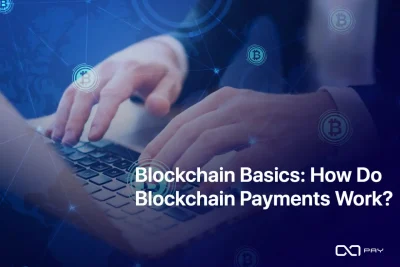Криптоадреса однозначно идентифицируют кошельки и позволяют пользователям безопасно отправлять и получать цифровые активы в сетях blockchain. В этой статье объясняется, как создавать криптоадреса, выделяются ключевые различия между типами адресов, а также описываются действия, которые помогут избежать ошибок при проведении транзакций. Овладев этими основами, вы возьмете под контроль свои криптовалютные транзакции и сократите количество дорогостоящих ошибок в блокчейн-платежах.
Раздел 1: Как криптографические процессы создают криптоадреса
Криптовалютный адрес - это уникальная буквенно-цифровая строка, полученная в результате криптографического процесса, которая позволяет пользователям получать криптовалютные платежи. Формат адреса зависит от сети блокчейна, к которой он принадлежит, что обеспечивает совместимость с конкретной сетью.
Процесс генерации адресов
Криптоадреса создаются на основе криптографии с открытым ключом.
Первый, пользователь генерирует закрытый ключ — секретное число, которое подписывает и защищает транзакции.
СледующийСистема применяет алгоритмы шифрования для получения соответствующего открытого ключа.
Наконец-то, Функции хэширования преобразует открытый ключ в криптоадрес, обеспечивая безопасность и эффективность.
Пример адреса биткойна
Адрес биткойна обычно начинается с 1, 3 или bc1, в зависимости от типа:
| Тип адреса | Начинается с | Пример адреса |
|---|---|---|
| Наследие (P2PKH) | 1 | 1A1zP1eP5QGefi2DMPTfTL5SLmv7DivfNa |
| SegWit (P2SH) | 3 | 3J98t1WpEZ73CNmQviecrnyiWrnqRhWNLy |
| Bech32 (нативный SegWit) | bc1 | bc1qar0srrr7xfkvy5l643lydnw9re59gtzzwfuflzz |
У каждого блокчейна свой формат адресов кошельков, и отправка средств на несовместимый адрес может привести к потере транзакций.
Раздел 2: Личные ключи, открытые ключи и адреса
Для безопасного использования криптовалюты важно понимать взаимосвязь и различия между адресом кошелька, открытым и закрытым ключом. Хотя все они являются частью одной и той же криптографической системы, каждый из них играет свою роль в обеспечении безопасности и работе с цифровыми активами.
Закрытый ключ - самый чувствительный компонент
Закрытый ключ - это длинная, случайно сгенерированная строка символов, используемая для подписания и авторизации транзакций. Он является наиболее важной частью криптокошелек и должен быть полностью конфиденциальным. Любой, кто получит доступ к вашему закрытому ключу, сможет распоряжаться вашими средствами. Закрытые ключи никогда не должны передаваться друг другу, храниться небрежно или вводиться на ненадежных устройствах.
Открытый ключ - производная от закрытого ключа
Закрытый ключ использует математические алгоритмы для генерации открытого ключа, которым вы можете поделиться публично. В свою очередь, открытый ключ проверяет подписи транзакций и служит основой для создания адреса вашего кошелька. Хотя открытый ключ менее чувствителен, чем закрытый, он все же раскрывает некоторую информацию и обычно хранится внутри кошелька.
Адрес кошелька - удобный идентификатор
Криптоадрес - это сокращенная и закодированная версия открытого ключа, предназначенная для более удобного использования при отправке и получении платежей. Он скрывает сложность открытого ключа и является единственной частью информации, которую необходимо предоставить, чтобы кто-то мог отправить вам средства.
Пример:
- Закрытый ключ:5HueCGU8rMjxEXxiPuD5BDu...(никогда не делится)
- Открытый ключ:04bfcab6...(используется внутри компании)
- Адрес:1A1zP1eP5QGefi2DMPTfTL5SLmv7DivfNa(разделены для получения)
- Закрытый ключ: 5HueCGU8rMjxEXxiPuD5BDu... (никогда не предоставляется)
- Открытый ключ: 04bfcab6... (используется внутренне)
- Адрес: 1A1zP1eP5QGefi2DMPTfTL5SLmv7DivfNa (общий для получения)
Почему это важно
Путаница в этих элементах может привести к серьезным рискам для безопасности. Некоторые пользователи по ошибке сообщают не адрес, а свой закрытый ключ, что приводит к безвозвратной потере средств. Хорошим правилом является следующее:
✅ Сообщите только свой адрес
❌ Никогда не передавайте свой закрытый ключ.
Понимание этих различий поможет вам безопасно управлять своим кошельком, правильно проверять транзакции и снизить риск человеческой ошибки.
Раздел 3: Форматы криптоадресов по сетям
Форматы адресов криптовалют различаются блокчейн-сети и разработаны для обеспечения совместимости и безопасности. У каждого блокчейна своя структура, префикс и метод кодирования. Понимание различий между этими форматами помогает пользователям избежать ошибок и гарантирует, что средства будут отправлены по назначению.
Общие форматы адресов по сетям
Понимание того, как различаются форматы адресов в разных сетях блокчейн, помогает предотвратить ошибки и обеспечить безопасность переводов. Ниже приведена краткая информация о наиболее распространенных форматах:
Биткоин (BTC):
Начинается с: 1 (Наследие), 3 (P2SH), или bc1 (Bech32)
Пример: 1A1zP1eP5QGefi2DMPTfTL5SLmv7DivfNa
Биткоин Кэш (BCH):
Два формата:
- Наследие (начинается с
1или3, аналогично BTC) - CashAddr (начинается с
биткоинкаш:илиq)
Пример: bitcoincash:qzm4... или qzm4w08...
Ethereum (ERC-20):
Начинается с: 0x
Пример: 0x89205A3A3b2A69De6Dbf7f01ED13B2108B2c43e7
🔸 Сети второго уровня на Ethereum (тот же формат - 0x):
Эти сети наследуют формат адресов Ethereum, но работают на разных цепочках:
- Арбитрум Один / Арбитрум Нова
- Оптимизм
- zkSync
- База
- Полигон (POS-цепочка)
Примечание: Хотя эти сети используют тот же формат адресов, что и Ethereum (0x), они представляют собой отдельные среды. Всегда проверяйте, правильную ли сеть вы используете в своем кошельке или dApp.
Смарт-цепочка Binance (BEP-20):
Начинается с: 0x
Формат идентичен Ethereum, но работает на другой цепочке.
Пример: 0x3dB8125B7eD20Cb726b5566aD87c74f02A82D0A2
Трон (TRC-20):
Начинается с: T
Пример: TPy8uoKqKxWBKzZ8f7kTQbr5nQQX5yvpHS
Солана (SOL):
Формат: Длинные буквенно-цифровые символы База58 строка
Пример: 5jvUdxR6NQkK8P1fSoU7uyCTptCwSL9JgnY1o1XgWcJm
Полигон (MATIC):
Также используется совместимый с Ethereum 0x формат
Пример: 0xA39fA4C8b33e0C6c9F2D8b8b1D3E57C2BbE9C90F
Тонкоин (TON):
Формат: Используется base64-кодированные строки
Может включать контрольную сумму и идентификатор рабочей цепи
Пример: EQBM5Ogu9D...
Dogecoin (DOGE):
Монеро (XMR):
- Начинается с:
4 - Полный адрес: 95 символов (стандартный адрес) или 106 символов (интегрированный адрес)
- Пример:
49dW...
✅ Адреса Monero не связаны с публичной бухгалтерской книгой, как у Bitcoin или Ethereum, и обеспечивают сильную встроенную конфиденциальность.
Одинаковые адреса в разных сетях
Некоторые сети, такие как Ethereum, BSC и Polygon, используют один и тот же формат адреса 0x, но каждая из них работает на отдельном блокчейне. Это сходство может привести к ошибочным транзакциям при выборе неправильной сети.
Почему это рискованно
- Выглядит достоверно, но переходит на неправильную цепочку
- Большинство кошельков не могут автоматически определить несоответствие
- Восстановление затруднено, если обе цепи не поддерживаются
Как избежать этой ошибки
- Всегда проверяйте стандарт токена (ERC-20, BEP-20 и т. д.).
- Подтвердите выбранную сеть в своем кошельке или на бирже
- Используйте кошельки, поддерживающие предупреждения или ярлыки, характерные для конкретной сети
Кончик: Никогда не думайте, что адрес, выглядящий как правильный, можно использовать в нескольких цепочках. Даже с одинаковым префиксом сети блокчейн не являются взаимозаменяемыми.
Раздел 4: Повторное использование адресов, одноразовые адреса и риски конфиденциальности
Криптоадреса могут быть как статическими (используемыми многократно), так и одноразовыми (уникальными для каждой транзакции). Хотя оба типа служат для определенных целей, их использование напрямую влияет на отслеживание транзакций и конфиденциальность пользователей.
Адреса одноразового использования
Эти адреса генерируются динамически для каждой транзакции и обычно используются:
- Криптовалютные биржи и платежные шлюзы
- Кошельки, ориентированные на конфиденциальность
- Платформы, требующие четкого распределения средств по заказам
Преимущества:
- Предотвращение повторного использования адресов
- Усложните связывание транзакций
- Улучшение конфиденциальности пользователей и отслеживание средств
Статические адреса
А статический адрес остается неизменным с течением времени. Часто используется:
- Лица, получающие регулярные выплаты
- Предприятия без автоматизированных систем
- Страницы для пожертвований или публичные профили
Недостатки:
- Позволяет легко отследить все операции, связанные с одним адресом
- Снижение уровня конфиденциальности в прозрачных блокчейнах
Примечание: Инструменты анализа блокчейна могут создавать подробные профили на основе статической активности адресов.
Лучшие практики в области конфиденциальности
Для защиты финансовой конфиденциальности:
- Используйте кошельки, которые генерируют новый адрес для каждой транзакции
- Рассмотрите такие решения, ориентированные на конфиденциальность, как скрытые адреса, CoinJoin или обфускация транзакций.
- Избегайте повторного использования адресов в деловых или личных целях, если это не требуется

Раздел 5: Как предотвратить отправку криптовалюты по неправильному адресу
Ошибочная отправка криптовалюты по неправильному адресу - одна из самых распространенных и дорогостоящих ошибок в криптовалютном мире. В отличие от традиционных систем, Транзакции в блокчейне необратимыЭто означает, что после отправки средств их невозможно вернуть, если только получатель не пойдет на сотрудничество. К счастью, есть несколько практических шагов, которые пользователи могут предпринять, чтобы снизить риск ошибок и обеспечить безопасную и правильную обработку транзакций.
Дважды проверьте адрес перед отправкой
Прежде чем подтвердить транзакцию, всегда проверяйте адрес кошелька получателя. Копируя и вставляя адрес или сканируя QR-код, дважды проверьте начальные и конечные символы, чтобы убедиться, что ничего не было изменено.
🟢 Встроенные контрольные суммы помогут обнаружить ошибки
Многие форматы криптоадресов включают контрольную сумму - механизм, который помогает обнаружить простые ошибки при вводе. Если какой-либо символ введен неправильно, кошельки могут пометить адрес как недействительный и предотвратить транзакцию. Хотя эта функция есть не во всех форматах и не может выявить все проблемы, она добавляет дополнительный уровень защиты от человеческих ошибок.
Использование адреса allowlisting
Некоторые кошельки и биржи позволяют пользователям создавать список доверенных адресов кошельков. Если эта функция включена, переводы разрешены только на одобренные адреса, что снижает риск отправки средств в незнакомое или неправильное место назначения.
Проверьте сеть
Криптоадреса в разных блокчейн-сетях могут выглядеть одинаково. Например, в Ethereum и Binance Smart Chain используются адреса, начинающиеся с "0x", но они не взаимозаменяемые. Отправка токенов не в ту сеть может привести к их безвозвратной потере, если кошелек получателя не поддерживает несколько цепочек.
🟢 Обеспечьте совместимость кошелька с форматом адреса
Даже если формат адреса выглядит правильным, кошелек получателя может быть несовместим со стандартом токенов или блокчейном, который вы используете. Всегда проверяйте, поддерживает ли кошелек получателя предполагаемую сеть и тип токена, прежде чем приступать к транзакции.
Проведите небольшую тестовую транзакцию
Прежде чем отправлять большую сумму, сначала переведите небольшую. Это поможет убедиться в правильности адреса, сети и совместимости кошелька, прежде чем совершать полный платеж.
Избегайте ручного ввода адресов
Криптоадреса длинные и чувствительные к регистру, поэтому при ручном вводе они подвержены ошибкам. Чтобы свести ошибки к минимуму, всегда используйте функцию копирования-вставки или сканируйте QR-код, предоставленный получателем.
🟢 Используйте QR-коды и форматы URI для обеспечения безопасности
Многие кошельки поддерживают запросы на оплату с помощью QR-коды или Ссылки URI, такие как bitcoin:address?amount=1,5. Эти инструменты включают в себя заранее заданные данные, например сумму или назначение платежа, и снижают вероятность ошибок при ручном вводе. Они особенно полезны для мобильных пользователей и личных сделок.
Будьте внимательны к атакам на подмену адресов
Хакеры могут попытаться перехватить или подменить адреса кошельков с помощью манипуляций с буфером обмена или тактики фишинга. Поэтому необходимо дважды проверить, чтобы вставленный вами адрес точно совпадал с оригиналом. Кроме того, не переходите по подозрительным ссылкам, которые могут вести на вредоносные сайты. Чтобы еще больше повысить безопасность, используйте аппаратные кошельки или платформы, которые предлагают уровни подтверждения транзакций.
✅ Краткое изложение ключевых советов:
- Всегда проверяйте полный адрес и правильность сети.
- Используйте QR-коды или ссылки URI, когда это возможно.
- Протестируйте небольшое количество, прежде чем переходить к большим объемам.
- Разрешите список доверенных адресов, если ваш кошелек поддерживает его.
- Остерегайтесь спуфинга и атак с использованием буфера обмена.
Заключение
Таким образом, правильное управление криптовалютными адресами является основополагающим фактором для обеспечения безопасных и успешных транзакций. Хотя структура, лежащая в основе этих адресов, может показаться технической, понимание их форматов, избежание межсетевой путаницы и применение безопасных методов могут иметь решающее значение.
Если вы будете бдительны, проверять каждую деталь и использовать методы, учитывающие конфиденциальность, вы сможете минимизировать риски и ориентироваться в криптовалютной экосистеме с большей уверенностью и контролем.
Использовать Криптовалютный шлюз OxaPay принимать криптовалюту в вашем бизнесе или легко управлять цифровыми активами.
От безопасных платежей до кошелька Telegram — OxaPay обеспечивает вам полный контроль без лишних сложностей.




